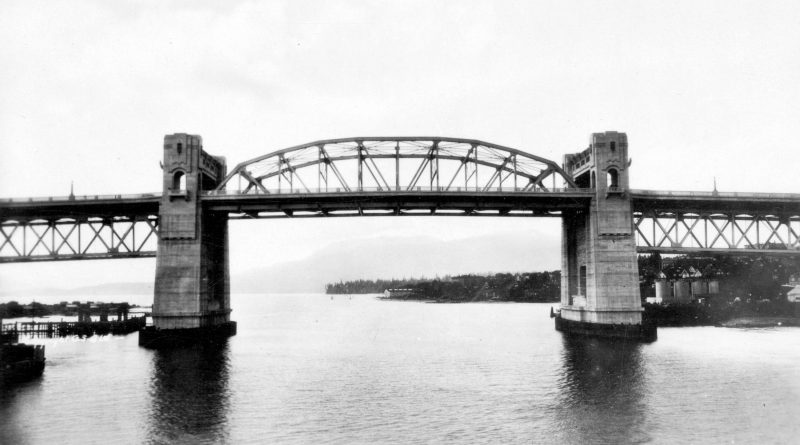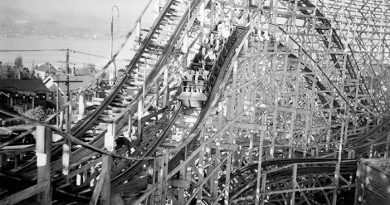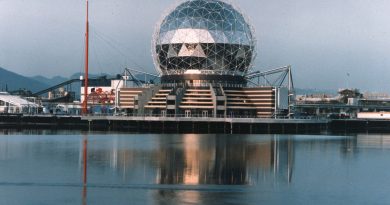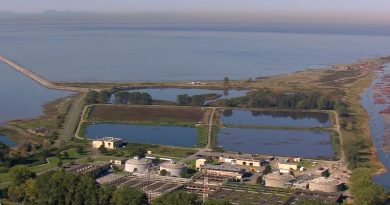1949
Above: Burrard Bridge Vancouver B.C.
[Image: Vancouver City Archives City of Vancouver Archives AM54-S4-: Br P3]
*****************************************
You’ll note that these years include events listed under “Also in . . .” These are events for which we don’t have a specific date. If YOU know the specific date of an event shown there, please notify us . . . and cite the source! Many thanks!
*****************************************
January 3 The Sun’s Page One headline January 4 about the police raid the night before on three local establishments was great: POLICE OPEN WAR ON NIGHT CLUB DRINKING.
Imagine! People drinking liquor in a nightclub! Next thing you know, they’ll be dancing! Chief Constable Walter Mulligan warned that his dry squad men were “definitely going to tighten up on liquor drinking in cabarets.” Detectives swooped down on three cabarets and confiscated 13 bottles of liquor from underneath tables. Five were seized from the Cave Cabaret, two from the Palomar (one of the men summonsed at the Palomar was well-known entertainer Fran Dowie), and four more at the Mandarin.
The B.C. Cabaret Owners’ Association blamed “rabid prohibitionists.” “These attempted curbs on drinking,” they added, “will only drive drink into vice dens, autos and hotel rooms.”
Much has changed in 56 years, and we can thank the officials of the COA, among others, for that. “Figuratively rubbing their hands,” the Sun reported, “the COA said ‘Good! At last we can fight a test case out in the open over B.C.’s ridiculous liquor laws.”
January 10 RCA Records introduced a new format for music recordings: seven-inch singles that ran at 45 rpm. The new records came with a large centre hole, easier to mount on the spindle. New “drop-changer” players could play these records for 50 minutes without interruption.
January 16 Streetcar service on the Kitsilano Beach run was discontinued by BC Electric.
January The second Hotel Vancouver, since 1914 one of the city’s most outstanding landmarks, was torn down. It was the largest wrecking job ever undertaken in the British Commonwealth. “There is no alternative,” read newspaper reports, “as no hotel operator is willing to buy, rehabilitate and operate it at his own risk.”
January 29 Harry Duker, Chairman of the Vancouver Tourist Association fund-raising campaign, told the Sun he was aiming for $75,000 in operating funds for 1949. “During the year (1948) 70,000 persons came to the association’s headquarters at Georgia and Seymour for information . . .”
February 12 Peter Ladner, Vancouver city councillor and vice-president of the Business in Vancouver Media Group, was born. Business in Vancouver is the successful weekly business newspaper.
March 5 Burrard Bridge engineer Major J.R. Grant reacted to remarks by a local art teacher that the bridge (opened in 1932) was a “monstrosity.” F.A. Ames of the Vancouver Art School had told a Lions Club gathering that the bridge pillars were “ashcans with a gasoline station on top.” Grant explained, said the Sun, that the pillars “were built as large as they are on request from the harbormaster, who wanted them prominent to avoid a navigation hazard at the False Creek entrance.” He went on to explain that the large base of the piers was required because at the time (1932) the B.C. Electric Railway had planned running a railway on a lower deck beneath the roadway. “That railway will never go in now,” Grant said. “The BCER is no longer interested.” He pooh-poohed Ames’ criticisms, said he’d rather trust the “esthetic ideas of the engineer.”
March 23 The Vancouver Rose Growers’ Society was formed.
March 29 The sale of margarine was approved, but, thanks to lobbying by the dairy industry (which feared, rightly, the new product would hurt sales of butter), it had to be sold white, not yellow.
April 1 Newfoundland entered Confederation.
Also April 1 Native Indian people got the vote in BC. On-reserve residents will not get the federal vote until 1960. BC also gave its Japanese citizens the vote.
April 6 The Princess Marguerite arrived in BC.
April 7 The Rodgers and Hammerstein musical South Pacific premiered on Broadway.
April 22 Margarine went on sale. It was packed, colored white, into plastic bags. Included inside the bag: a small pill of food coloring which had to be popped open inside the bag by the consumer and kneaded into the margarine to make it yellow.
May 31 The new Labour Temple opened on West Broadway.
June 15 Fire on the False Creek waterfront caused $1 million damage.
June 25 Sod was turned for Woodward’s Department store at Park Royal. See December 3.
July 1 Canadian Pacific Airlines launched its inaugural flight to Sydney, Australia. Then, on the 13th, they carried the first all-Canadian airmail to Australia.
July 23 The Province, in a story on local tourist activity, ran a photo of “travel advisors” Doris Young, Alyse Francis and Anita Zanon. “They reply to all queries, even stupid ones, with courteous, sensible information.” Hedley Hipwell, president of the Vancouver Tourist Association, referred to “Vancouver’s $30 million tourist industry . . .” The VTA’s travel advisors, Hipwell explained, deal with from 600 to 700 visitors a day. “In 1948 they answered 120,000 phone calls. In 1927 there were 24,000 . . . Last year, the girls gave out 160,000 travel folders and maps, answered 11,400 direct and 50,000 letters from other tourist bureaus, 8,000 coupon advertisement enquiries. They wrote invitations to 9,000 convention prospects . . . One of VTA’s biggest jobs is finding rooms for folk who arrive in Vancouver without reservations. It takes the full time of one advisor to find accommodation for them.”
August 12 Rick Antonson, the president and CEO of Tourism Vancouver, was born in Vancouver. Tourism Vancouver, representing 1,200 member businesses, is responsible for marketing Greater Vancouver to the world. Antonson is an irrepressible promoter of the city’s attractions and a tireless reminder that tourism is a major economic force here. See this site.
August 15 Kingsway was re-opened as a six-lane highway between Vancouver and New Westminster. It was described as “strikingly handsome” in the newspapers.
Also August 15 Radio’s Jack Cullen, who was switching stations, did his last show at CKMO and his first show at CKNW at the same time. He had taped his ’MO show earlier, did his ’NW show live.
August 16 Margaret Mitchell, the author of Gone With The Wind, was fatally injured when hit by a speeding taxicab near her home in Atlanta, Georgia.
August 21 The biggest quake in BC’s recorded history, 8.1 on the Richter scale, occurred off the Queen Charlotte Islands. Its major force was felt to the uninhabited west of the Queen Charlotte Islands and damage was minimal. “While hardly anyone in Vancouver felt the tremors, reports of the quake poured in from throughout B.C. . . . Prince George residents ran into the streets shouting ‘earthquake, earthquake,’ as cafe signs swung and poles swayed.” Centres 1,500 miles (2,400 km) apart felt the quake, and it was even detected in Jasper, Alberta. Seattle measured it at 7.2. The Province reported on Page One that a clock had stopped in the home of Mrs. Laurie Sanders, Imperial Street in Burnaby.
September 10 Gloria Cranmer, future film maker and linguist, born in Alert Bay July 4, 1931, became this year the first native Indian woman to attend the University of British Columbia. She graduated in anthropology (in 1956). Her contributions to British Columbia native life are remarkable. She was awarded the Heritage Society of British Columbia’s Heritage Award in 1996. And for more, see this site.
October 22 The first “official” tree was planted at Queen Elizabeth Park. It was called Little Mountain Park back then, carved out of a rock quarry and chosen as the site of Canada’s first civic arboretum. “The tree looked lonely and a trifle battered,” the Province wrote. “Fittingly enough, it was a Pacific dogwood, the only tree emblematic of B.C. It stood in a grassy spot overlooking the smoke and skyscrapers of downtown Vancouver.” The original idea for the arboretum, the paper reported, “was suggested by Leander Manley, secretary-manager of the Canadian Pulp and Paper Association, western branch.”
November 2 The Hope-Princeton Highway officially opened to traffic. The Highway (#3) closely followed the old Dewdney Trail, the interior route along which provisions were moved north, and gold and furs moved south. “When the Hope-Princeton highway opened,” says the Manning Park website, “it not only provided a major transportation link between the coast and interior, it also made accessible to people everywhere the premier provincial park in British Columbia.”
Also November 2 A civic banquet was given at the Hotel Vancouver for visiting Prime Minister Nehru of India.
November 9 One of Vancouver’s most sensational murder stories began early this day with the discovery of the body of Woodward’s employee Blanche Fisher, 45 and unmarried. The victim was found in False Creek near the Kitsilano Trestle. Suicide was first considered, but was ruled out when it was discovered she wore no shoes, stockings or underwear, and that there were many bruises on her body. What made the case extraordinary was the identity of the killer, who was eventually identified, charged and executed. His name was Frederick Ducharme, 34, a very odd and twisted piece of work, with a record for indecent exposure and bizarre behavior, which can’t be described here and which was only hinted at in the more straitlaced newspaper reporting of the day. Ms. Fisher’s umbrella was found in his car, and articles of her clothing in his squalid False Creek shack. (Jack Webster describes the case in detail in his autobiography.) The story ran for several months. Ducharme was found guilty of the murder and hanged July 14, 1950.
November 11 Kerrisdale Arena was officially opened. One of the people on hand was Fred “Cyclone” Taylor. Hockey legend Taylor was president of the Point Grey Community Centre Association at the time. Park board chairman Bert Emery, acting mayor R.K. Gervin and Harry Duker, who managed the raising of funds for the building, were on hand too.
November 27 The Capilano River, swollen by a violent rainstorm, swept away a large section of Marine Drive, the only road link at the time to West Vancouver. Washed away as well was part of the bridge over the Capilano, so army engineers from Sardis rushed in to build an emergency Bailey bridge. That was also washed away, and West Vancouver would be cut off for 10 days.
December 1 Grouse Mountain Chairlift opened, the world’s first double chairlift. It replaced a two- to three-hour hike from the skiers’ bus stop at the base of the mountain.
December 3 A photograph appeared in the Province showing the site for something called a “shopping centre” on the north shore. It would be called Park Royal. It was Canada’s first shopping centre.
December 4 Dick Diespecker’s radio column in the Province—which followed local and international radio personalities in precisely the way we cover TV and movie stars today—told us that “dynamic young sportscaster” Ray Perrault had left CJOR to join the radio department of the O’Brien Advertising Agency. Today, of course, he’s Senator Ray Perrault.
December 11 Boxer Jimmy McLarnin laid the cornerstone for Sunset Memorial Centre on East 51st Avenue. McLarnin had played a large part in the establishment of the Centre (which is now called the Sunset Community Centre.) When Stan Thomas, one of the people involved in the creation of the complex, went to Hollywood in 1947 it was McLarnin—whom Thomas knew—who introduced him to Bing Crosby, a friend of McLarnin’s. Bing agreed to come up to Vancouver and record his radio show here to kick off the Centre’s fund-raising campaign. Bing’s show was recorded at the Forum September 22, 1948, attended by 9,000 people.
December 23 There was a farewell parade of Vancouver’s Seaforth Highlanders today, held for their retiring commanding officer, Lt.-Col. D.M. Clark. Part of the ceremony included an inspection by Brig. J.M. Rockingham of the Seaforth’s ski company. These special troops, we said, would train on Mount Seymour.
December 29 We confess: we don’t understand this story. A box called “The Thing” was put out to float in English Bay by the leaders of the Polar Bear Club. When it was brought into shore on January 1, 1951 during the swim it was opened to reveal an effigy of Stalin, which was ceremoniously burned.
Also in 1949
CKNW moved from 1230 on the dial to 1320.
An American movie partly made in Vancouver more than 50 years ago actually took place here! How often does that happen? The 1949 thriller, Johnny Stool Pigeon, starring Howard Duff, Shelley Winters, Dan Duryea and Tony Curtis, among others, told of international drug dealers tracked to their downtown Vancouver lair by a heroic U.S. Treasury agent. (Drugs in Vancouver? Ha! Never happen.)
A big song hit this year was There’s a Bluebird on Your Windowsill, written by a Vancouver nurse, Elizabeth Clarke. It became the first song written by a Canadian to sell a million copies. (Ironically, Ms. Clarke spent $600 of her own money to have the first recording of it made.) The story of how the song came to be written is charming. Read it here.
S.V. Smith became president of the Vancouver Real Estate Board.
Charles Edwin Thompson became mayor of Vancouver. Born September 17, 1890 in Grey County, Ontario, Thompson, writes Donna Jean McKinnon, “was a teacher, rancher, automotive dealer, and from 1945 to 1948 an alderman. His apparently contradictory combination of progressive and regressive policies make him a hard character to pin down. He felt that improvements to public transit, roadways and sewer lines and efforts to equalize civic taxes should be provided to law-abiding and politically correct citizens. However, civil liberties were impaired during his term through a policy requiring all civic employees to be screened for communist sympathies.”
Winnipeg-born writer George Woodcock moved to B.C., aged about 37. He gave us more than 120 books, the first a collection of poems published in 1938 when he was 26, the last a 1994 history of B.C. His biography of George Orwell, The Crystal Spirit (Governor General’s Award for non-fiction in 1966), and his writings on anarchism were well-received. There is a fine, long appreciation of him here, and an interview as well.
Calgary-born (June 8, 1912) Clyde Gilmour began writing movie reviews for the Vancouver Sun. He had been doing the same on CBC radio here since 1947. Both gigs lasted to 1954, then he went East to well-deserved national fame.
Penticton’s Mike Fitzpatrick liked our story in the September 20, 2005 Sun of the now-vanished News-Herald, and sent along this reminiscence (which we’ve given a date of 1949): “In the late forties and early fifties I as well as my pals had N-H paper routes in the McKenzie Dunbar areas. We of course were no different than all the others across town who were up at 4 am six days a week and off on our trusty CCM and Raleigh bikes. (No fancy 10-speeds yet). Our substation was at 41st and Collingwood, and I can easily remember the crews pulling up the street car tracks and paving 41st in preparation for the first trolley buses, the first trolley line in Vancouver I believe. We thought 41st Ave. was great with the new pavement at 5am, as there were no cars at that hour of the day and we could play soccer on the street while waiting for the papers when they were late, as they often were. Although there were only 5 routes from that substation they covered large areas compared to the Sun or Province routes as fewer people subscribed to the N-H. Two or three times a year we would do subscription drives, as they do today trying to get new customers for the paper. Often, if we were able to get enough new subscriptions we would be taken to Bellingham for the day (always a Saturday). It was a big day for a group of 12 to 14 year olds. I remember so well the manager, Ian French, who drove us down to Bellingham. He owned a beautiful brand new Olds 98 on our last trips. It of course was the best car that we had ever been in as none of our families could ever afford anything like that in those days. I often wonder if Ian French is still going, as I have good memories of him during those great times. It is always interesting reading your articles.”




